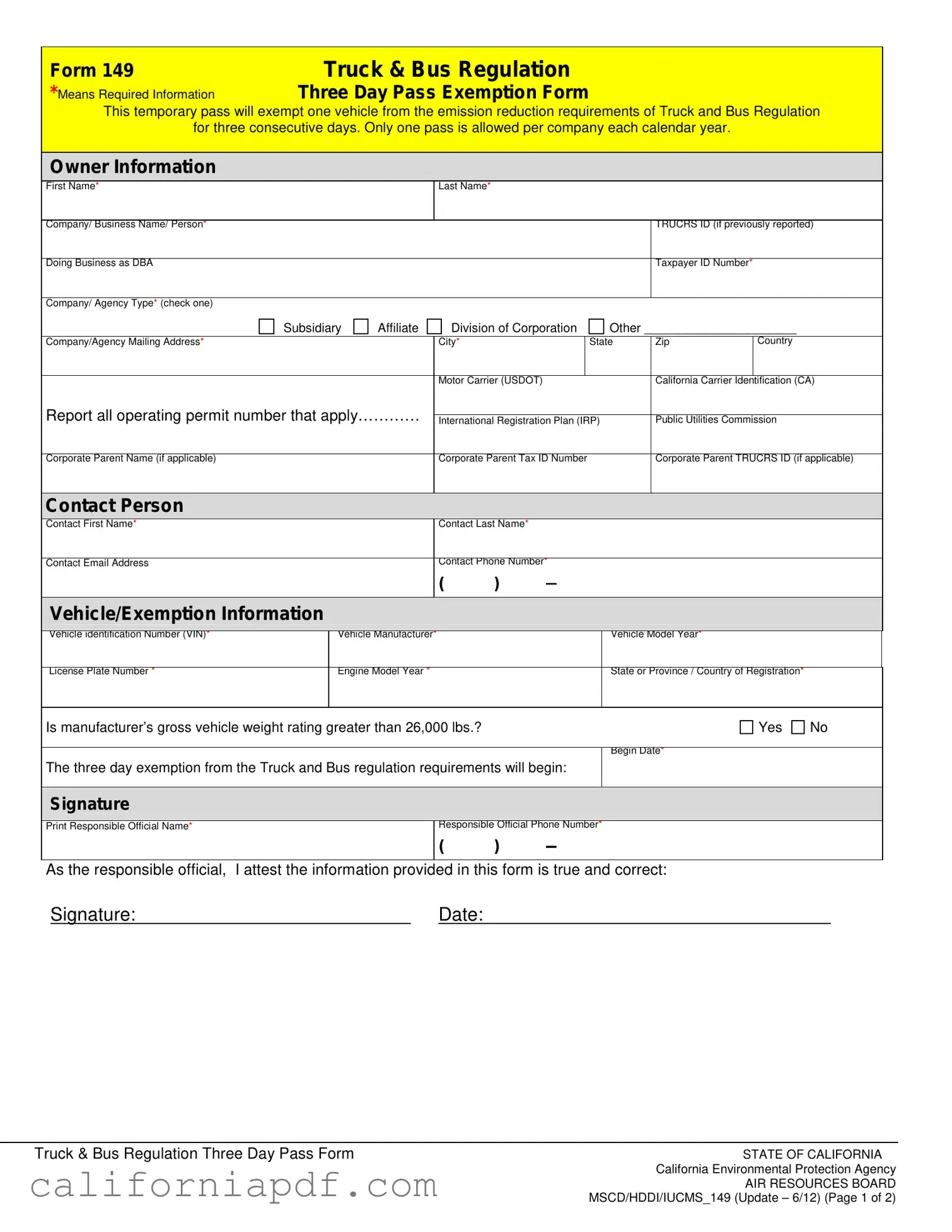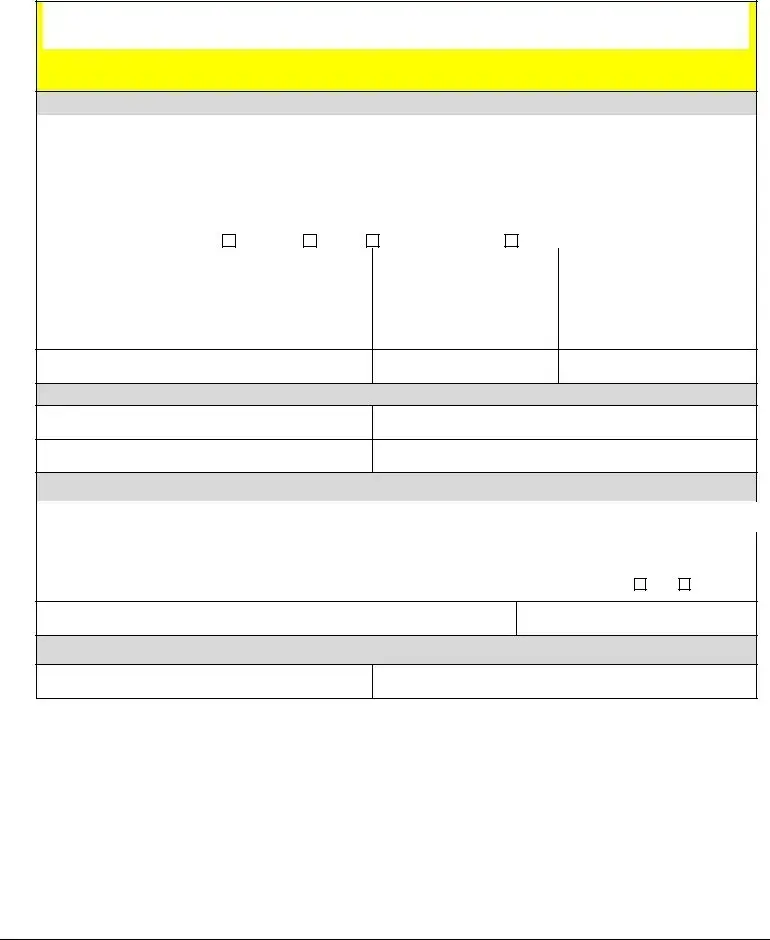Form 149 |
Truck & Bus Regulation |
*Means Required Information |
Three Day Pass Exemption Form |
This temporary pass will exempt one vehicle from the emission reduction requirements of Truck and Bus Regulation
for three consecutive days. Only one pass is allowed per company each calendar year.
Owner Information
First Name* |
Last Name* |
|
|
|
Company/ Business Name/ Person* |
|
TRUCRS ID (if previously reported) |
|
|
|
Doing Business as DBA |
|
Taxpayer ID Number* |
|
|
|
Company/ Agency Type* (check one) |
|
|
Other ______________________
Company/Agency Mailing Address* |
City* |
State |
Zip |
Country |
|
|
|
|
|
|
Motor Carrier (USDOT) |
|
California Carrier Identification (CA) |
Report all operating permit number that apply………… |
|
|
International Registration Plan (IRP) |
Public Utilities Commission |
Corporate Parent Name (if applicable)
Corporate Parent Tax ID Number
Corporate Parent TRUCRS ID (if applicable)
Contact First Name*
Contact Email Address
Contact Last Name*
Contact Phone Number*
( ) −
Vehicle/Exemption Information
Vehicle identification Number (VIN)* |
Vehicle Manufacturer* |
Vehicle Model Year* |
|
|
|
License Plate Number * |
Engine Model Year * |
State or Province / Country of Registration* |
|
|
|
Is manufacturer’s gross vehicle weight rating greater than 26,000 lbs.?
The three day exemption from the Truck and Bus regulation requirements will begin:
Print Responsible Official Name*
Responsible Official Phone Number*
( ) −
As the responsible official, I attest the information provided in this form is true and correct:
Truck & Bus Regulation Three Day Pass Form |
STATE OF CALIFORNIA |
|
California Environmental Protection Agency |
|
AIR RESOURCES BOARD |
|
MSCD/HDDI/IUCMS_149 (Update – 6/12) (Page 1 of 2) |
What is a Three Day Pass?
A Three Day Pass is a temporary permit that allows a fleet owner to operate one vehicle per calendar year in California that does not meet the emission reduction requirements of the Truck and Bus regulation. The three day period begins at 12:00 am on the date you specify on the form.
How do I obtain a Three Day Pass?
You must complete a request form and submit the information to the Air Resources Board (ARB) three days prior to the vehicle entering California. The pass will be granted as long as it is the first request made by the fleet in the calendar year. If the ARB fails to respond by the date of the vehicles planned entry, the vehicle may operate in California for the requested three-day period. The vehicle operator must present a copy of the form to Air Resources Board personnel upon request, or the fleet owner may be subject to penalties.
Mail the Request for the Three Day Pass to:
Truck & Bus Reporting, 5th Floor
PO BOX 2815
California Air Resources Board
Sacramento, CA 95812
You may also fax the form to our office at (916)323-5526, or Email the forms to us at trucrs@arb.ca.gov
Is there a limit on the number of miles I can operate under this pass?
There are no mileage limits for a vehicle operating during the three day period specified in an approved Three Day Pass.
Do I need a Three Day Pass?
If you reported the vehicle as part of your fleet to use the phase in option or flexibility options in the regulation, and your fleet is in compliance, you do not need a three day pass. The following are situations that you should use a three day pass:
•If you reported to use flexibility options but you need to temporarily bring a vehicle into California that you did not report.
•If you are using the model year schedule to comply (not required to report) and you want to temporarily bring a noncompliant truck into California. A summary of the engine model year schedule for heavier trucks is shown below
Engine Model Year Schedule for Heavier Trucks (More than 26,000 lb GVWR)
|
Engine year |
|
|
PM Filter by: |
|
|
2010 Engine by: |
|
|
|
|
|
|
|
|
|
|
|
|
|
|
|
|
|
1993 & Older |
|
|
Not Required |
|
|
January 1, 2015 |
|
1994-1995 |
|
|
Not Required |
|
January 1, 2016 |
|
|
|
|
|
|
|
1996-1999 |
|
|
January 1, 2012 |
|
|
January 1, 2020 |
|
2000-2004 |
|
|
January 1, 2013 |
|
January 1, 2021 |
|
|
|
|
|
|
|
2005-2006 |
|
|
January 1, 2014 |
|
|
January 1, 2022 |
|
|
2007 & Newer |
|
Already Equipped |
|
January 1, 2023 |
If your truck has a gross vehicle weight rating (GVWR) between 14,001 and 26,000 pounds your first compliance date is not until January 1, 2015. An overview of the Truck and Bus regulation compliance requirements are available at http://www.arb.ca.gov/msprog/onrdiesel/documents/FSRegSum.pdf.
If you have any questions or need help completing the form, please contact us at 866-6DIESEL (866-634-3735) or by email at: 8666diesel@arb.ca.gov.


